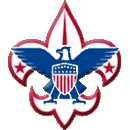| MERIT BADGES |
|
|
|
|
| Note: Eagle Required are in Italics |
"A"
American
Business
American Culture
American Heritage
American Labor
Animal Science
Archaeology
Archery
Architecture
Art
Astronomy
Athletics
Atomic Energy
Auto Mechanics
Aviation
"B"
Backpacking
Basketry
Bird Study
Bugling
"C"
Camping
Canoeing
Chemistry
Cinematography
Citizenship
Community*
Citizenship Nation*
Citizenship World*
Climbing
Coin Collecting
Collections
Communications*
Computers
Cooking
Crime Prevention
Cycling*
"D"
Dentistry
Disability Awareness
Dog Care
Drafting
"E"
Electricity
Electronics
Emergency
Preparedness**
Energy
Engineering
Entrepreneurship
Environmental
Science*
"F"
Family Life*
Farm Mechanics
Fingerprinting
Fire Safety
First Aid*
Fish & Wildlife Mgmt.
Fishing
Fly Fishing
Forestry
"G"
Gardening
Genealogy
Geology
Golf
Graphic Arts
"H"
Hiking
Home Repairs
Horsemanship
"I"
Indian Lore
Insect Studies
"J"
Journalism
"K"
"L"
Landscape Architecture
Law
Leatherwork
Lifesaving**
"M"
Mammal Study
Medicine
Metalwork
Model Design & Building
Motorboating
Music
"N"
Nature
"O"
Oceanography
Orienteering
"P"
Painting
Personal Fitness**
Personal Management*
Pets
Photography
Pioneering
Plant Science
Plumbing
Pottery
Public Health
Public Speaking
Pulp and Paper
"Q"
"R"
Radio
Railroading
Reading
Reptile & Amphibian Study
Rifle Shooting
Rowing
"S"
Safety
Salesmanship
Scholarship
Sculpture
Shotgun Shooting
Skating
Skiing
Small Boat Sailing
Soil & Water
Conservation
Space Exploration
Sports**
Stamp Collecting
Surveying
Swimming**
"T"
Textile
Theatre
Traffic Safety
Truck Transportation
"U"
"V"
Veterinary Medicine
"W"
Water Skiing
Weather
Whitewater
Wilderness Survival
Wood Carving
Woodwork
"X"
"Y"
"Z"
 Astronomy AstronomyRequirements 1983 |
- Do the following:
- Sketch the face of the moon, indicating on it the locations of at least five seas and five craters.
- Within a single week sketch the position of the moon in the sky at the same hour on three different evenings. Explain the changes observed.
- Tell what factors keep the moon in orbit around the earth.
- Do ONE of the following:
- Photograph or locate on a map of the sky a planet at approximately weekly intervals at the same time of night for at least 4 weeks. Explain any changes noticed on the photographs or map.
- Find out when each of the five visible planets will be observable in the evening sky during the next 12 months and compile this information in the form of a chart or table.
- Do ONE of the following:
- In a sketch show the position of Venus, Mars, or Jupiter in the sky at approximately weekly intervals at the same time for at least 4 weeks.
- Using a compass, record the direction to the sun at sunset at approximately weekly intervals for at least 4 weeks in spring or fall (for 6 to 8 weeks in summer or winter) and relate this information to the seasons of the earth.
- With the aid of diagrams explain the relative positions of sun, earth, and moon at the times of lunar and solar eclipses and at the times of New, First Quarter, Full, and Last Quarter phases of the moon.
- Using the shadow of a vertical pole in sunshine, lay out a true north-south line (a meridian). Then, using a line and the pole on another day, measure the altitude of the noontime sun and determine your latitude.
- Identify in the sky at least 10 constellations, four of which are in the Zodiac.
Identify at least eight conspicuous stars, five of which are of first magnitude. Then do
the following:
- Show in a sketch the position of the Big Dipper and its relation to the North Star and the horizon early some evening and again 6 hours later the same night. Record the date and time of making each sketch.
- Explain what we see when we look at the Milky Way.
- With the aid of diagrams (or real telescopes if available) explain the difference between reflecting and refracting telescopes. Describe the basic purpose of a telescope, and list at least three other instruments used with telescopes.
- Do the following:
- Describe the composition of the sun, its relationship to other stars and some effects of its radiation on the Earth's weather. Define sunspots and describe some of the effects they may have on this radiation.
- Identify at least one star that is red, one that is blue, and one that is yellow, and explain the meaning of these colors.
- Do ONE of the following:
- Visit a planetarium or observatory and submit a report to your counselor both on the activities occurring there and on the exhibits of instruments and other astronomical objects you observed.
- Spend at least 3 hours observing celestial objects through a telescope or field glass, and write a report for your counselor on what you observed.
- Name different career opportunities in astronomy. Explain how to prepare for one of them. List the high school courses most useful in beginning such preparation.
|
||||||
Last Update May 15, 2023

.jpg)
